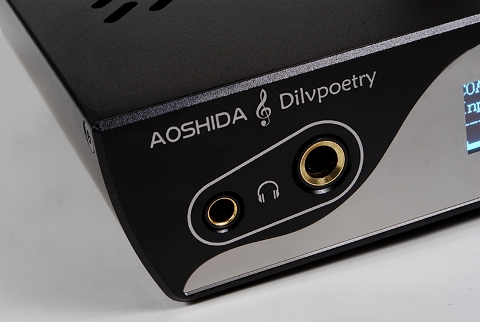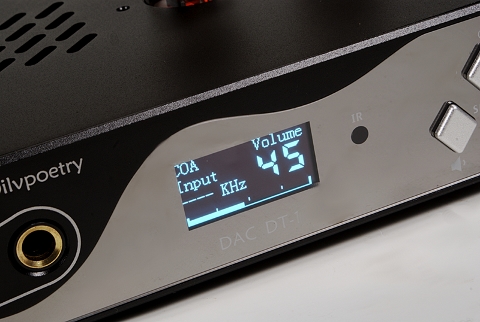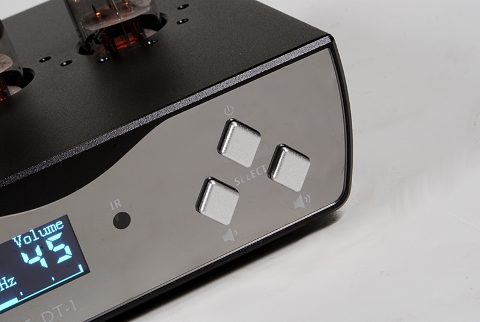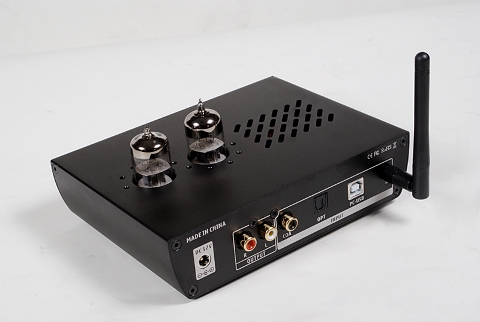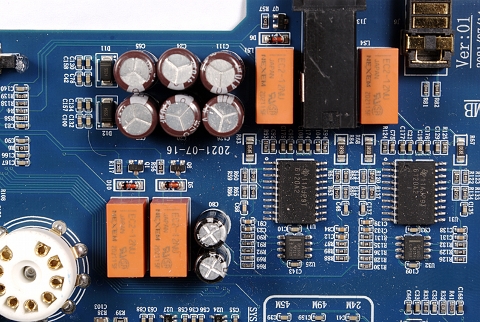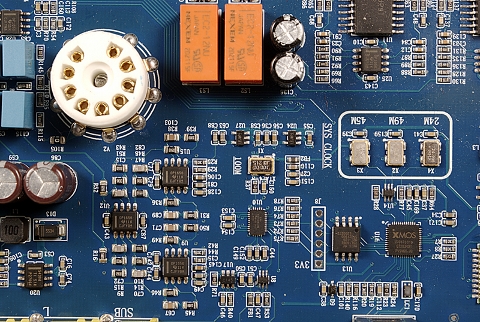about Audio, High Fidelity
& Home Entertainment technologies
pid: 607-2025/10/01 (v1.2)
Privacy Policy
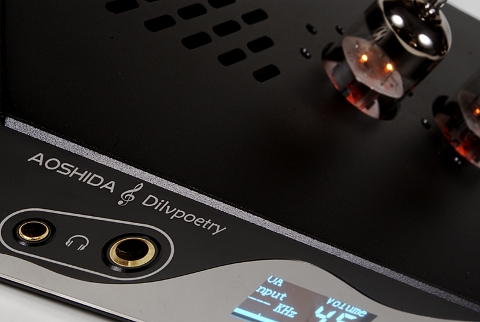
DT-1 will immediately gain your attention, despite its small size. Apart from the two tubes nicely protruding at the top, the reflective finish of the facade and the somewhat asymmetrically curved side surfaces, make the device stand out, without any effort, but also without any feeling of excess compared to a standard chassis.
The aesthetics of DT-1 are quite interesting. Main features include the tubes protruding at the top of the chassis, the highly reflective front panel finish, and the curved side surface.
The user interface is quite simple: a small but very legible OLED display (which can be turned off) show the basic information about the device status including the sample rate and the attenuation level. Three diamond-shaped push-on buttons control the attenuation, the power -on and the headphone amplifier mode. The device can be set to automatically select between the headphone amp and the DAC/Preamplifier (via Line out) mode, just by inserting the headphones jack to the relevant output, or operating with both outputs enabled simultaneously.
Users can connect two headphone sets, one using the single-ended 6,35mm TRS jack and one using the balanced 4.4mm TRRRS jack.
Despite its small size the OLED display is very legible even from a long distance. It can be turned off through the remote control.
The headphone amplifier allows for driving two headphone sets at the same time, one with a conventional, single-ended connection, via a TRS 6,35mm jack and a balanced connection, via a TRRRS 4.4mm jack. The device stores in memory the attenuation that the user selected while using the headphones and while through the Line Out so that there is no chance to use an inappropriate level adjustment by mistake.
The connectivity offered by DT-1 is typical. On the back, the user will find conventional S/PDIF, coaxial (RCA), and optical (Toslink) digital inputs, a USB-B port, and a Line Out (RCA). There, the Bluetooth antenna is also found, through which an ad-hoc wireless connection for audio streaming can be carried out, supporting, between other codecs, aptX HD. Sample rates supported are up to 32-bit/768kHz (PCM) and DSD512 (DSD) via the USB port, up to 32-bit/384kHz via the coaxial input, and up to 24-bit/192kHz via the optical input. To use the USB port with a Windows OS-based host, the Dilvpoetry offers the appropriate driver to download and suggests the use of foobar2000 in ASIO mode as a media player. Obviously, both Linux and Apple/Mac OS platforms are supported without the need of a driver.
The device is accompanied by a remote control through which all the options can be controlled, the most important being input selection, level setting, and the output mode selection (Tubes On/Tubes Off).
Connectivity in the back-panel includes standard digital inputs (both coaxial and optical), a USB port, and Line Out. There is also ad-hoc streaming via Bluetooth v5.0.
Opening the chassis reveals a well-disciplined, industrial-quality structure. The digital interface is based on an XMOS solution that leads the signal to an ESS (ES9038Q2M D/A) conversion chip. The 9038 features all the well-known tools ESS has to offer (Digital PLL, Time Domain Jitter Elimination, Sabre Architecture, and Digital Filter Selection - the latter not used in this case), followed by an analog stage based on Texas Instruments OPA1656 operational amplifiers. These are chips with a FET-based input stage, specially designed for very low noise. This stage is followed by a tube stage featuring a pair of 6N3 double triodes. The user can choose whether this stage will be used or not, both in the DAC/Preamplifier mode (i.e for the signals present at the Line output), where it plays the role of the output stage and in the DAC/Headphone amplifier, where it acts as a buffer stage, between the DAC and the power amp.
The headphone amplifier is implemented with two Texas Instruments TPA6120A2 chips, one per channel, which is driven by another OPA1656 each. The Bluetooth wireless connection is based on a Qualcomm SOC (CSR8675) that supports Bluetooth V5.0 and aptX, aptX Low Latency, aptX HD, MP3, AAC, and SBC codecs.
The power supply starts with a typical wall-mount power adapter, but inside the chassis, one can observe a good approach with enough filter capacity and local regulation circuits. Some interesting details are the clock circuit, based on three crystals to cover all basic sampling frequencies, and the fact that there are no signal-transport cables.
The construction is disciplined, with good industrial-level quality, which is over-sufficient for the price range. To the left, the tube stage and the power supplies, top right the headphone amplifier, bottom right the digital processor including the Bluetooth SOC and, in the middle, the opamp-based analog stage.
The headphone amplifier is based on two TPA6120A2, each of which is driven by an OPA1656 double opamp chip.
The digital interface features an XMOS processor with three different crystals for the clock circuit (to the right). It is followed by the ESS chip as well as three OPA1656 opamps that implement the solid-state analog stage.
Previous | Next | More Reviews


